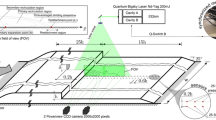Abstract
The present work investigates the lower boundary condition for flows over a steep, rough hill. Simple asymptotic arguments together with the mixing-length hypothesis are used to derive a local analytical solution that is tested against three different flow conditions. In all, 36 velocity profiles are compared with the proposed expression. The experiments were carried out in a water channel and velocity measurements were made through laser Doppler anemometry. The extent of separated flow was made to vary as a function of the roughness and the Reynolds number. The analysis includes regions of attached as well as separated flow. In particular, the solution of Stratford is studied at the points of separation and re-attachment and found to apply equally well in rough walls.
Similar content being viewed by others
References
Allen B, Brown AR (2002) Large-eddy simulation of turbulent separated flow over rough hills. Boundary-Layer Meteorol 102: 177–198
Andreopoulos J, Durst F, Zaric Z, Jovanovic J (1984) Influence of Reynolds number on characteristics of turbulent wall boundary layers. Exp Fluids 2: 7–16
Bevington PR (1969) Data reduction and error analysis for the physical sciences. McGraw-Hill, New York, 351 pp
Brown AR, Hobson JM, Wood N (2001) Large-eddy simulation of neutral turbulent flow over rough sinusoidal ridges. Boundary-Layer Meteorol 98: 411–441
Castro IP (2007) Rough-wall boundary layers: mean flow universality. J Fluid Mech 585: 469–485
Castro IP, Apsley DD (1997) Flow and dispersion over topography: a comparison between numerical and laboratory data for two-dimensional flows. Atmos Environ 31: 839–850
Cheng H, Castro IP (2002) Near-wall flow development after a step change in surface roughness. Boundary-Layer Meteorol 105: 411–432
Clauser FH (1954) Turbulent boundary layers in adverse pressure gradients. J Aeronaut Sci 21: 91–108
Cruz DOA, Silva Freire AP (1998) On single limits and the asymptotic behaviour of separating turbulent boundary layers. Int J Heat Mass Transfer 41: 2097–2111
Cruz DOA, Silva Freire AP (2002) Note on a thermal law of the wall for separating and recirculating flows. Int J Heat Mass Transfer 45: 1459–1465
Fernholz HH, Krause E, Nockemann M, Schober M (1995) Comparative measurements in the canonical boundary layer at Re δ2 ≤ 6 × 104 on the wall of the DNW. Phys Fluids A 7: 1275–1281
Finnigan JJ (1983) A streamlined coordinate system for distorted turbulent shear flows. J Fluid Mech 130: 241–258
Flack KA, Schultz MP, Connely JS (2007) Examination of a critical roughness height for outer layer. Phys Fluids 19: 95–104
Gad-el-Hak M, Bandyopadhyay PR (1994) Reynolds number effects in wall-bounded turbulent flows. Appl Mech Review 47: 307–365
Garratt JR (1992) The atmospheric boundary layer. Cambridge University Press, Cambridge, 316 pp
Goldstein S (1948) On laminar boundary layer flow near a position of separation. Quart J Mech Appl Maths 1: 43–69
Hewer FE (1998) Non-linear numerical model predictions of flow over an isolated hill of moderate slope. Boundary-Layer Meteorol 87: 381–408
Hunt JCR, Leibovich S, Richards KJ (1988) Turbulent shear flow over low hills. Quart J Roy Meteorol Soc 114: 1435–1470
Iizuka S, Kondo H (2004) Performance of various sub-grid scale models in large-eddy simulations of turbulent flow over complex. Atmos Environ 38: 7083–7091
Jackson PS, Hunt JCR (1975) Turbulent wind flow over a low hill. Quart J Roy Meteorol Soc 101: 929–955
Kaplun S (1967) Fluid mechanics and singular perturbations. Academic Press, 369 pp
Kim HG, Patel VC (2000) Test of turbulence models for wind flow over terrain with separation and recirculation. Boundary-Layer Meteorol 94: 5–21
Krogstad PA, Antonia RA (1999) Surface roughness effects in turbulent boundary layers. Exp Fluids 27: 450–460
Lagerstrom PA, Casten RG (1972) Basic concepts underlying singular perturbation techniques. SIAM Rev 14: 63–120
Loureiro JBR, Soares DV, Fontoura Rodrigues JLA, Pinho FT, Silva Freire AP (2007a) Water tank and numerical model studies of flow over steep smooth two-dimensional hills. Boundary-Layer Meteorol 122: 343–365
Loureiro JBR, Pinho FT, Silva Freire AP (2007b) Near wall characterization of the flow over a two-dimensional steep smooth hill. Exp Fluids 42: 441–457
Mellor GL (1966) The effects of pressure gradients on turbulent flow near a smooth wall. J Fluid Mech 24: 255–274
Mellor GL (1972) The large Reynolds number, asymptotic theory of turbulent boundary layers. Int J Eng Sci 10: 851–873
Nakayama A, Koyama H (1984) A wall law for turbulent boundary layers in adverse pressure gradients. AIAA J 22: 1386–1389
Oke TR (1987) Boundary layer climates. Routledge, London, 435 pp
Perry AE, Joubert PN (1963) Rough-wall boundary layers in adverse pressure gradients. J Fluid Mech 17: 193–211
Perry AE, Schofield WH, Joubert PN (1969) Rough-wall turbulent boundary layers. J Fluid Mech 37: 383–413
Prandtl L (1925) Über die ausgebildete Turbulenz. ZAMM 5: 136–139
Ross AN, Arnold S, Vosper SB, Mobbs SD, Nixon N, Robins AG (2004) A comparison of wind-tunnel experiments and numerical simulations of neutral and stratified flow over a hill. Boundary-Layer Meteorol 113: 427–459
Schlichting H (1979) Boundary layer theory. McGraw Hill, New York, 817 pp
Snyder WH, Castro IP (2002) The critical Reynolds number for rough-wall boundary layers. J Wind Eng Ind Aerodyn 90: 41–54
Stratford BS (1959) The prediction of separation of the turbulent boundary layer. J Fluid Mech 5: 1–16
Sychev VV, Sychev VV (1987) On turbulent boundary layer structure. PMM USSR 51: 462–467
Sykes RI (1980) An asymptotic theory of incompressible turbulent boundary-layer flow over a small hump. J Fluid Mech 101: 647–670
von Kármán Th (1930) Mechanische ahnlichkeit und turbulenz. Proc Third Intern Congress for Appl Mech, Stockholm
Yajnik KS (1970) Asymptotic theory of turbulent shear flow. J Fluid Mech 42: 411–427
Ying R, Canuto VM (1997) Numerical simulation of the flow over two-dimensional hills using a second-order turbulence closure model. Boundary-Layer Meteorol 85: 447–474
Author information
Authors and Affiliations
Corresponding author
Rights and permissions
About this article
Cite this article
Loureiro, J.B.R., Monteiro, A.S., Pinho, F.T. et al. Water-Tank Studies of Separating Flow Over Rough Hills. Boundary-Layer Meteorol 129, 289–308 (2008). https://doi.org/10.1007/s10546-008-9314-x
Received:
Accepted:
Published:
Issue Date:
DOI: https://doi.org/10.1007/s10546-008-9314-x




